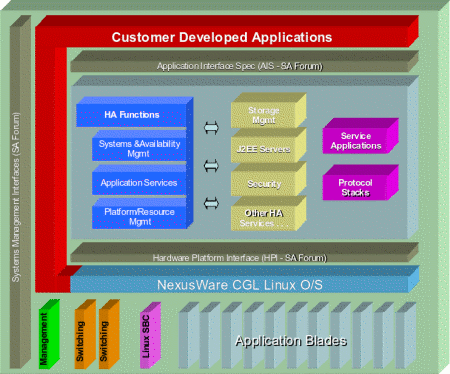NEP achieves Carrier Grade Linux 4.0 registration
Apr 14, 2008 — by Eric Brown — from the LinuxDevices Archive — 2 views Network equipment provider (NEP) Performance Technologies (PT) announced that its NexusWare Linux distribution meets the Carrier Grade Linux (CGL) 4.0 requirements specified by the Linux Foundation (LF). PT is the third vendor after Wind River and MontaVista to register CGL 4.0 compliance.
Network equipment provider (NEP) Performance Technologies (PT) announced that its NexusWare Linux distribution meets the Carrier Grade Linux (CGL) 4.0 requirements specified by the Linux Foundation (LF). PT is the third vendor after Wind River and MontaVista to register CGL 4.0 compliance.
NexusWare complies fully with CGL 4.0, says PT. Based on the 2.6.20 Linux kernel, it also integrates software from the OpenHPI project, which aims to maintain an open source implementation of the Service Availability Forum (SAF) HPI (hardware platform interface) specification.
PT sells blades, AdvancedMC (AMC) modules, chassis management systems, and other networking equipment. It is unique among NEPs in that it maintains its own CGL distribution. The NexusWare distro and “NexusWare Studio” suite of Eclipse-based development tools are bundled with PT products, such as its recently announced MTC5070 MicroTCA platform.

NexusWare development environment
In June, PT announced NexusWare version 12, which added support for PowerPC processor architectures, along with other features aimed at CGL 4.0 readiness (more details below). In October 2006, PT joined the Open Source Development Labs (OSDL), and then registered NexusWare with the LF's (then the OSDL's) CGL 3.2 specification.
CGL is the standard choice for network equipment based on Advanced Telecommunications Computing Architecture (ATCA). CGL 4.0 defines about 250 individual requirements divided into seven categories: availability, clustering, serviceability, performance, standards, hardware, and security. Each category is separated into mandatory, desired, and roadmap priority levels.
Announced in February 2007, 4.0 registration has proceeded slowly. The first registration wasn't announced until a year later, when Wind River announced CGL 4.0 compliance for Wind River Platform for Network Equipment, Linux Edition 2.0. Since then, CGL pioneer MontaVista has quietly registered its MontaVista Carrier Grade Edition 5.0.
In November, CGL working group chairman Dan Cauchy admitted that the group had lost some momentum during the OSDL/LF merger in early 2007, but he said the group had recently become rejuvenated, an assertion borne out by the recent flurry of CGL 4.0 registrations.

NexusWare 12 architecture
(Click to enlarge)
NexusWare V12
PT's NexusWare 12 supports IPv6, as well as IPv4. Several available add-on modules bring support for specialized protocols, such as:
- MTP2 — used in telecom signal switching
- SIP — used in VoIP
- Frame relay
- HDLC — used in military monitoring applications
- x25 — used in radar systems
In addition to NexusWare Studio, the NexusWare development environment includes a suite of GNU/EGCS cross-development tools (CDT), compilers (C, C++), debuggers, profilers, libraries, and embedded tools that build software images for the embedded targets. A kernel debugger is said to support development of custom drivers for target systems, and utilities are available for making a bootable image in flash memory. There is also a Kernel Builder configuration tool that enables developers to add or remove kernel elements.
Stated PT product manager Steven Wigent, “Linux plays a key role in migrating customers off proprietary systems and onto COTS platforms.”
LF's CGL 4.0 registration page is available here. More information on NexusWare may be found here.
This article was originally published on LinuxDevices.com and has been donated to the open source community by QuinStreet Inc. Please visit LinuxToday.com for up-to-date news and articles about Linux and open source.